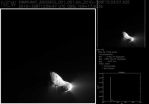(Press-News.org) COLLEGE PARK, Md. – The University of Maryland-led EPOXI mission successfully flew by comet Hartley 2 at 10 a.m. EDT today, and the spacecraft has begun returning images. Hartley 2 is the fifth comet nucleus visited by any spacecraft and the second one visited by the Deep Impact spacecraft.
Scientists and mission controllers are studying never-before-seen images of Hartley 2 appearing on their computer terminal screens. See images at: http://epoxi.umd.edu/
"We are all holding our breath to see what discoveries await us in the observations near closest approach," said University of Maryland astronomer Michael A'Hearn, one of the originators of science team leader for both the Deep Impact mission and its follow on mission EPOXI.
At approximately 10 a.m. EDT, the spacecraft passed within 700 kilometers (435 miles) of the comet. Minutes after closest approach, the spacecraft's High-Gain Antenna was pointed at Earth and began downlinking vital spacecraft health and other engineering data stored aboard the spacecraft's onboard computer during the encounter. Twenty minutes later, the first images of the encounter made the 37 million kilometer (23 million mile) trip from the spacecraft to NASA's Deep Space Network antenna, appearing moments later on the mission's computer screens.
"The mission team and scientists have worked for this day," said Tim Larson, EPOXI project manager at NASA's Jet Propulsion Laboratory, Pasadena, Calif. "It's good to see Hartley 2 up close."
A post-encounter news conference featuring University of Maryland astronomers Michael A'Hearn, EPOXI principal investigator and Jessica Sunshine, deputy principal investigator, will be held at 1 p.m. PDT (4 p.m. EDT) in the von Karman auditorium at JPL. It will be carried live on NASA TV. Downlink and schedule information is online at http://www.nasa.gov/ntv . The event will also be carried live on http://www.ustream.tv/nasajpl2 .
A Deeper Impact on Planetary Science
With the latest EPOXI mission data on Hartley 2, the Deep Impact spacecraft is adding to an already extensive scientific legacy. Launched in January 2005, the spacecraft made scientific history and world-wide headlines when it smashed a probe into comet Tempel 1 on July 4th of that year. Following the conclusion of that mission, a Maryland-led team of scientists won approval from NASA to fly the Deep Impact spacecraft to a second comet.
The name EPOXI itself is a combination of the names for the two extended mission components: the extrasolar planet observations, called Extrasolar Planet Observations and Characterization (EPOCh), and the flyby of comet Hartley 2, called the Deep Impact Extended Investigation (DIXI). During the EPOCh phase of EPOXI, the Deep Impact spacecraft provided information on possible extrasolar planets and was one of three spacecraft to find for the first time clear evidence of water on Moon. A study accepted for publication in The Astrophysical Journal and just released by NASA, provides "colorful" findings on Earth and other planets in our solar system that someday may help identify earthlike worlds around other stars.
The overall objective of the flyby of Hartley 2 is the same as that for the Deep Impact mission's trip to Tempel 1: to learn more about the origin and history of our solar system by learning more about the composition and diversity of comets. Comets contain material from the early days of the solar system before the planets formed. "If we understand the comets really well it will tell us how the planets got made," explained A'Hearn. "That's why we choose comets to study."
INFORMATION:
NASA's Jet Propulsion Laboratory, Pasadena, Calif., manages the EPOXI mission for NASA's Science Mission Directorate, Washington. The University of Maryland, College Park, is home to the mission's principal investigator, Michael A'Hearn and eight other members of the EPOXI science team. Drake Deming of NASA's Goddard Space Flight Center, Greenbelt, Md., is the science lead for the mission's extrasolar planet observations. The spacecraft was built for NASA by Ball Aerospace & Technologies Corp., Boulder, Colo.
UMD-led deep impact spacecraft successfully flies by comet Hartley 2
2010-11-05
ELSE PRESS RELEASES FROM THIS DATE:
Researchers unlock the secret of bacteria's immune system
2010-11-05
Quebec City, November 4, 2010—A team of Université Laval and Danisco researchers has just unlocked the secret of bacteria's immune system. The details of the discovery, which may eventually make it possible to prevent certain bacteria from developing resistance to antibiotics, are presented in today's issue of the scientific journal Nature.
The team led by Professor Sylvain Moineau of Université Laval's Department of Biochemistry, Microbiology, and Bioinformatics showed that this mechanism, called CRISPR/Cas, works by selecting foreign DNA segments and inserting them ...
A 'brand' new world: Attachment runs thicker than money
2010-11-05
Can you forge an emotional bond with a brand so strong that, if forced to buy a competitor's product, you suffer separation anxiety? According to a new study from the USC Marshall School of Business, the answer is yes. In fact, that bond can be strong enough that consumers are willing to sacrifice time, money, energy and reputation to maintain their attachment to that brand.
"Brand Attachment and Brand Attitude Strength: Conceptual and Empirical Differentiation of Two Critical Brand Equity Drivers," a study published in the November issue of the Journal of Marketing, ...
X-rays offer first detailed look at hotspots for calcium-related disease
2010-11-05
Menlo Park, Calif.—Calcium regulates many critical processes within the body, including muscle contraction, the heartbeat, and the release of hormones. But too much calcium can be a bad thing. In excess, it can lead to a host of diseases, such as severe muscle weakness, a fatal reaction to anesthesia or sudden cardiac death.
Now, using intense X-rays from the Stanford Synchrotron Radiation Lightsource (SSRL) at the Department of Energy's SLAC National Accelerator Laboratory, researchers have determined the detailed structure of a key part of the ryanodine receptor, a ...
Colonic navigation
2010-11-05
Nanoparticles could help smuggle drugs into the gut, according to a study published this month in the International Journal of Nanotechnology.
There are several drugs that would have more beneficial therapeutic effects if they could be targeted at absorption by the lower intestine. However, in order to target the colon for treating colon cancer for instance, medication delivered by mouth must surmount several barriers including stomach acidity, binding to mucus layers, rapid clearance from the gut, and premature uptake by cells higher up the gastrointestinal tract. Being ...
Helical CT scans reduce lung cancer mortality by 20 percent compared to chest X-rays
2010-11-05
PROVIDENCE, R.I. [Brown University] — In a major new study announced today by the National Cancer Institute, researchers including Brown University biostatistian Constantine Gatsonis and his colleagues found that screening for lung cancer using helical CT scanning reduced lung cancer deaths by 20 percent compared to using chest X-rays.
"The findings we're announcing today offer the first definitive evidence for the effectiveness of helical CT screening smokers for lung cancer " said Gatsonis, a lead biostatistician in the study and director of the American College of ...
Motor Neurone Disease Association study identifies MND biomarker
2010-11-05
A study funded by the Motor Neurone Disease (MND) Association, in collaboration with the Medical Research Council (MRC), has identified a common signature of nerve damage in the brains of MND patients.
The study's exciting findings have been published in the prestigious journal Neurology (2 November 2010). These are the first results to be published from the ongoing Oxford Study for Biomarkers in MND/ALS (BioMOx).
MND research is being held back by the lack of an early diagnostic test and predictable markers of the progression of the disease – biomarkers. Patients ...
The mind uses syntax to interpret actions
2010-11-05
Most people are familiar with the concept that sentences have syntax. A verb, a subject, and an object come together in predictable patterns. But actions have syntax, too; when we watch someone else do something, we assemble their actions to mean something, according to a new study published in Psychological Science, a journal of the Association for Psychological Science.
"There are oceans and oceans of work on how we understand languages and how we interpret the things other people say," says Matthew Botvinick of Princeton University, who cowrote the paper with his ...
AGU Journal highlights -- Nov. 4, 2010
2010-11-05
The following highlights summarize research papers that have been recently published in Geophysical Research Letters (GRL), Journal of Geophysical Research - Atmospheres (JGR-D), and Journal of Geophysical Research - Earth Surface (JGR-F).
1. Exploring climate patterns linking stratosphere, lower atmosphere
Roughly every 28 months, the zonal winds in the stratosphere at the equator cycle from easterly to westerly and then back to easterly. Known to atmospheric scientists as the quasi-biennial oscillation (QBO), these shifting wind patterns result when the energy from ...
Discovery shows promise against severe side effects
2010-11-05
November 4, 2010 – (BRONX, NY) -- A team of scientists has found a way to eliminate a debilitating side effect associated with one of the main chemotherapy drugs used for treating colon cancer. The strategy used in their preclinical research—inhibiting an enzyme in bacteria of the digestive tract—could allow patients to receive higher and more effective doses of the drug, known as CPT-11 or Irinotecan.
The study, spearheaded by scientists at the University of North Carolina at Chapel Hill and involving collaborators at Albert Einstein College of Medicine of Yeshiva University ...
Volcanic eruptions affect rainfall over Asian monsoon region
2010-11-05
Scientists have long known that large volcanic explosions can affect the weather by spewing particles that block solar energy and cool the air.
Some suspect that extended "volcanic winters" from gigantic eruptions helped kill off dinosaurs and Neanderthals.
In the summer following Indonesia's 1815 Tambora eruption, frost wrecked crops as far away as New England, and the 1991 blowout of the Philippines' Mount Pinatubo lowered average global temperatures by 0.7 degrees F--enough to mask the effects of greenhouse gases for a year or so.
Now, in research funded by the ...


